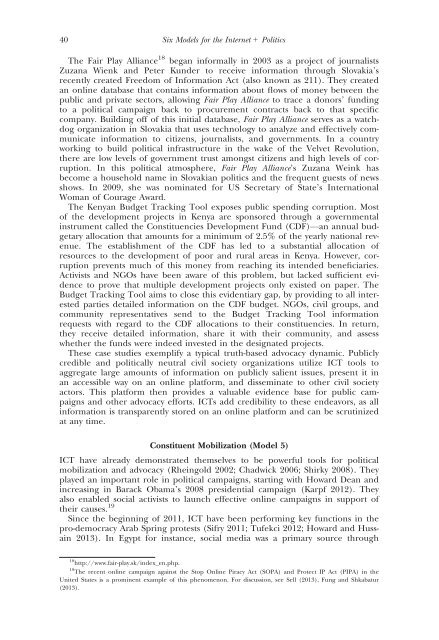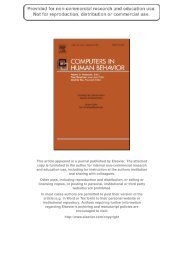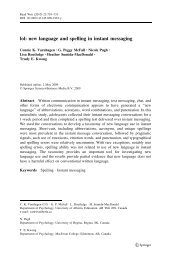Six Models for the Internet + Politics
You also want an ePaper? Increase the reach of your titles
YUMPU automatically turns print PDFs into web optimized ePapers that Google loves.
40 <strong>Six</strong> <strong>Models</strong> <strong>for</strong> <strong>the</strong> <strong>Internet</strong> + <strong>Politics</strong><br />
The Fair Play Alliance 18 began in<strong>for</strong>mally in 2003 as a project of journalists<br />
Zuzana Wienk and Peter Kunder to receive in<strong>for</strong>mation through Slovakia’s<br />
recently created Freedom of In<strong>for</strong>mation Act (also known as 211). They created<br />
an online database that contains in<strong>for</strong>mation about flows of money between <strong>the</strong><br />
public and private sectors, allowing Fair Play Alliance to trace a donors’ funding<br />
to a political campaign back to procurement contracts back to that specific<br />
company. Building off of this initial database, Fair Play Alliance serves as a watchdog<br />
organization in Slovakia that uses technology to analyze and effectively communicate<br />
in<strong>for</strong>mation to citizens, journalists, and governments. In a country<br />
working to build political infrastructure in <strong>the</strong> wake of <strong>the</strong> Velvet Revolution,<br />
<strong>the</strong>re are low levels of government trust amongst citizens and high levels of corruption.<br />
In this political atmosphere, Fair Play Alliance’s Zuzana Weink has<br />
become a household name in Slovakian politics and <strong>the</strong> frequent guests of news<br />
shows. In 2009, she was nominated <strong>for</strong> US Secretary of State’s International<br />
Woman of Courage Award.<br />
The Kenyan Budget Tracking Tool exposes public spending corruption. Most<br />
of <strong>the</strong> development projects in Kenya are sponsored through a governmental<br />
instrument called <strong>the</strong> Constituencies Development Fund (CDF)—an annual budgetary<br />
allocation that amounts <strong>for</strong> a minimum of 2.5% of <strong>the</strong> yearly national revenue.<br />
The establishment of <strong>the</strong> CDF has led to a substantial allocation of<br />
resources to <strong>the</strong> development of poor and rural areas in Kenya. However, corruption<br />
prevents much of this money from reaching its intended beneficiaries.<br />
Activists and NGOs have been aware of this problem, but lacked sufficient evidence<br />
to prove that multiple development projects only existed on paper. The<br />
Budget Tracking Tool aims to close this evidentiary gap, by providing to all interested<br />
parties detailed in<strong>for</strong>mation on <strong>the</strong> CDF budget. NGOs, civil groups, and<br />
community representatives send to <strong>the</strong> Budget Tracking Tool in<strong>for</strong>mation<br />
requests with regard to <strong>the</strong> CDF allocations to <strong>the</strong>ir constituencies. In return,<br />
<strong>the</strong>y receive detailed in<strong>for</strong>mation, share it with <strong>the</strong>ir community, and assess<br />
whe<strong>the</strong>r <strong>the</strong> funds were indeed invested in <strong>the</strong> designated projects.<br />
These case studies exemplify a typical truth-based advocacy dynamic. Publicly<br />
credible and politically neutral civil society organizations utilize ICT tools to<br />
aggregate large amounts of in<strong>for</strong>mation on publicly salient issues, present it in<br />
an accessible way on an online plat<strong>for</strong>m, and disseminate to o<strong>the</strong>r civil society<br />
actors. This plat<strong>for</strong>m <strong>the</strong>n provides a valuable evidence base <strong>for</strong> public campaigns<br />
and o<strong>the</strong>r advocacy ef<strong>for</strong>ts. ICTs add credibility to <strong>the</strong>se endeavors, as all<br />
in<strong>for</strong>mation is transparently stored on an online plat<strong>for</strong>m and can be scrutinized<br />
at any time.<br />
Constituent Mobilization (Model 5)<br />
ICT have already demonstrated <strong>the</strong>mselves to be powerful tools <strong>for</strong> political<br />
mobilization and advocacy (Rheingold 2002; Chadwick 2006; Shirky 2008). They<br />
played an important role in political campaigns, starting with Howard Dean and<br />
increasing in Barack Obama’s 2008 presidential campaign (Karpf 2012). They<br />
also enabled social activists to launch effective online campaigns in support of<br />
<strong>the</strong>ir causes. 19<br />
Since <strong>the</strong> beginning of 2011, ICT have been per<strong>for</strong>ming key functions in <strong>the</strong><br />
pro-democracy Arab Spring protests (Sifry 2011; Tufekci 2012; Howard and Hussain<br />
2013). In Egypt <strong>for</strong> instance, social media was a primary source through<br />
18 http://www.fair-play.sk/index_en.php.<br />
19 The recent online campaign against <strong>the</strong> Stop Online Piracy Act (SOPA) and Protect IP Act (PIPA) in <strong>the</strong><br />
United States is a prominent example of this phenomenon. For discussion, see Sell (2013), Fung and Shkabatur<br />
(2013).
















